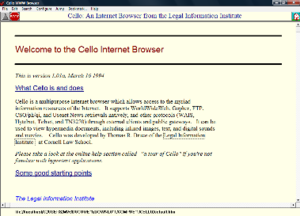Cello (web browser)

|
|
| Original author(s) | Thomas R. Bruce |
|---|---|
| Developer(s) | Legal Information Institute at Cornell Law School |
| Initial release | 8 June 1993 |
| Last release |
1.01a / 16 April 1994
|
| Development status | Discontinued |
| Written in | C++, makes "heavy use of Borland Object Windows libraries" |
| Operating system | Windows 3.1 / 3.11, OS/2,Windows NT 3.5 |
| Size | 325 kb |
| Available in | English |
| Type | Web browser |
| License | Shareware/Proprietary |
| Website | www.law.cornell.edu/cello/ at the Wayback Machine (archived 4 February 2005) |
Cello was an early graphical web browser for Windows 3.1, developed by Thomas R. Bruce of the Legal Information Institute at Cornell Law School. It was released as shareware in 1993. While other browsers ran on various Unix machines, Cello was the first web browser for Microsoft Windows, using the winsock system to access the Internet. In addition to the basic Windows, Cello worked on Windows NT 3.5 and with small modifications on OS/2.
Cello was created because of a demand for Web access by lawyers, who were more likely to use Microsoft Windows than the Unix operating systems supporting earlier Web browsers, including the first release of Mosaic. The lack of a Windows browser meant many legal experts were unable to access legal information made available in hypertext on the World Wide Web. Cello was popular during 1993/1994, but fell out of favor following the release of Mosaic for Windows and Netscape, after which Cello development was abandoned.
Cello was first publicly released on 8 June 1993. A version 2.0 was announced, but development was abandoned. Version 1.01a, 16 April 1994, was the last public release. Since then, the Legal Information Institute at Cornell Law School has licensed the Cello 2.0 source code, which has been used to develop commercial software.
...
Wikipedia
